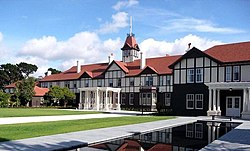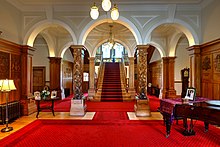
Edward Gibbon Wakefield is considered a key figure in the establishment of the colonies of South Australia and New Zealand. He also had significant interests in British North America, being involved in the drafting of Lord Durham's Report and being a member of the Parliament of the Province of Canada for a short time.

Sir William Fox was the second premier of New Zealand and held that office on four occasions in the 19th century, while New Zealand was still a colony. He was known for his confiscation of Māori land rights, his contributions to the education system, and his work to increase New Zealand's autonomy from Britain. He has been described as determined and intelligent, but also as bitter and "too fond" of personal attacks. Different aspects of his personality are emphasised by different accounts.
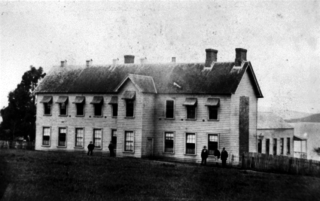
The 1st New Zealand Parliament was a term of the Parliament of New Zealand. It opened on 24 May 1854, following New Zealand's first general election. It was dissolved on 15 September 1855 in preparation for that year's election. 37 Members of the House of Representatives (MHRs) represented 24 electorates.

Thomas Spencer Forsaith, JP, was a New Zealand politician and an Auckland draper. According to some historians, he was the country's second premier, although a more conventional view states that neither he nor his predecessor should properly be given that title.
A Government House is any residence used by governors-general, governors and lieutenant-governors in the Commonwealth and the British Empire. Government Houses serve as the venue for governors' official business, as well as the many receptions and functions hosted by the occupant. Sometimes, the term Government House is used as a metonym for the governor or his office.

Government House, Auckland is the secondary official residence of the governor-general of New Zealand located in Auckland, New Zealand. The property is situated in the Auckland suburb of Mount Eden on Mountain Road.

The following lists events that happened during 1907 in New Zealand.

The governor-general of New Zealand is the representative of the monarch of New Zealand, currently King Charles III. As the King is concurrently the monarch of 14 other Commonwealth realms and lives in the United Kingdom, he, on the advice of his New Zealand prime minister, appoints a governor-general to carry out his constitutional and ceremonial duties within the Realm of New Zealand.

Major General Robert Henry Wynyard was a British Army officer and New Zealand colonial administrator, serving at various times as Lieutenant Governor of New Ulster Province, Administrator of the Government, and was the first Superintendent of Auckland Province.

The flag of the governor-general of New Zealand is an official flag of New Zealand and is flown continuously on buildings and other locations when a governor-general is present. The flag in its present form was adopted in 2008 and is a blue field with the shield of the New Zealand coat of arms royally crowned. The official heraldic description is "A flag of a blue field thereon the Arms of New Zealand ensigned by the Royal Crown all proper".

The New Zealand Constitution Act 1846 was an Act of the Parliament of the United Kingdom intended to grant self-government to the Colony of New Zealand, but it was never fully implemented. The Act's long title was An Act to make further Provision for the Government of the New Zealand Islands, and it received the royal assent on 28 August 1846.

Old Government House is the former residence of the governor of New Zealand in Auckland, New Zealand.
The following lists events that happened during 1853 in New Zealand.
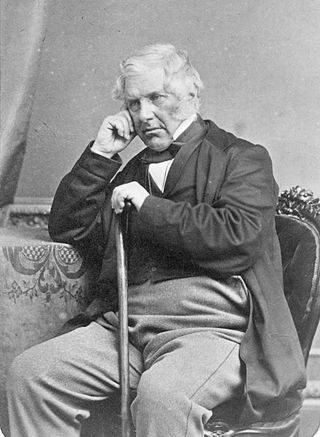
The Sewell Ministry was the first responsible government in New Zealand. Unlike previous executives, its members were held accountable to Parliament. This would form the basis for future governments in New Zealand.
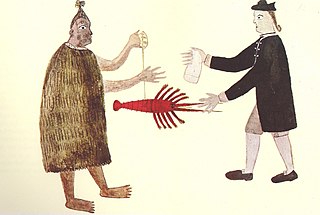
Wellington has been the capital of New Zealand since 1865. New Zealand's first capital city was Old Russell (Okiato) in 1840–41. Auckland was the second capital from 1841 until 1865, when Parliament was permanently moved to Wellington after an argument that persisted for a decade. As the members of parliament could not agree on the location of a more central capital, Wellington was decided on by three Australian commissioners.

The Colony of New Zealand was a colony of the United Kingdom of Great Britain and Ireland that encompassed the islands of New Zealand from 1841 to 1907. The power of the British Government was vested in the governor of New Zealand. The colony had three successive capitals: Okiato in 1841; Auckland from 1841 to 1865; and Wellington from 1865, which continues as the capital of New Zealand today.
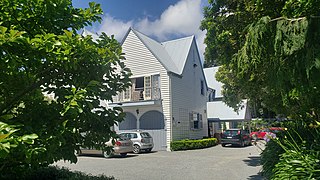
Vogel House at 75 Woburn Road, Lower Hutt, New Zealand is a neo-Georgian-style home built in 1933. For 13 years was the official residence of the Prime Minister of New Zealand, and it housed multiple other ministers and dignitaries.

The General Assembly House, colloquially called "Shedifice" by the members of Parliament, was the first building to house the New Zealand Parliament in Auckland. It was in use by Parliament from 1854 until 1864 during the time that Auckland was the capital of New Zealand. It was also used by the Auckland Provincial Council, with Auckland Province owning the building from 1858. After the abolition of the provincial government system, the building was used by the government's survey department and was then used by Auckland University College. The General Assembly House was demolished in 1917 to make way for Anzac Avenue. Today, a reserve adjacent to Parliament Street called Parliament Reserve commemorates the location where the New Zealand Parliament met initially.

Mansion House on Kawau Island, New Zealand, is a house that was owned by Sir George Grey from 1862 to 1888. Built in 1845 as the house for the manager of a copper mine on the island, it was extended significantly by Grey during his ownership. Mansion House is a heritage listed building. It is open to the public as part of the Kawau Island Historic Reserve administered by the Department of Conservation.
The Karitane Hospitals were six hospitals in New Zealand run by the Plunket Society, located in Auckland, Christchurch, Dunedin, Invercargill, Wanganui and Wellington. They were established as training hospitals for Karitane nurses and cared for babies with malnutrition and other dietetic complaints, and premature babies. They also offered mother care training and assistance. The first hospital opened in 1907 and the hospitals were closed between 1978 and 1980 due to financial difficulties and changes in society and maternity services.
